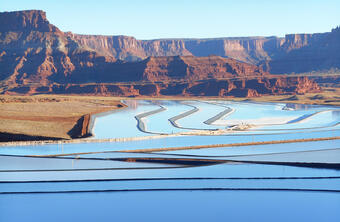Potash Cache: USGS Study Summarizes U.S. Sources of an Essential Nutrient for Agriculture
A new USGS report summarizes the primary sources of potash in the United States. Potash is an essential nutrient that, along with phosphorus and nitrogen, is used as fertilizer for growing crops.
Plants require potash for water uptake and photosynthesis. It also helps improve plants’ disease resistance and physical quality, and increases crop yield and shelf life.
The principal potash sources discussed in the study are the large, layered deposits that formed during retreat and evaporation of Paleozoic, intracontinental seas that intermittently inundated North America between about 420 and 280 million years ago. Layered potash beds are mined by traditional underground mining methods or by in situ solution mining.
Quaternary brine is another source of potash that is recovered by solar evaporation in manmade ponds. Brine is defined as saltwater that has a high concentration of sodium and chloride but can also contain calcium, magnesium, sulfate, potassium, iron, lithium and bromine along with multiple other trace elements. Brine from Quaternary surface water and groundwater sources are pumped to solar evaporation ponds where potash is concentrated, dried and harvested for processing and refinement.
Although there is sufficient potash to meet near-term demand, the large marine-type deposits are either geographically restricted to a few areas or are too deep to easily mine. Other regions lack sources of potash brine from groundwater or surface water. Thus, some areas of the world rely heavily on potash imports.
For more information about potash, visit: http://minerals.usgs.gov/minerals/pubs/commodity/potash/
USGS provides science for a changing world. Visit USGS.gov, and follow us on Twitter @USGS and our other social media channels.
Subscribe to our news releases via e-mail, RSS or Twitter.



